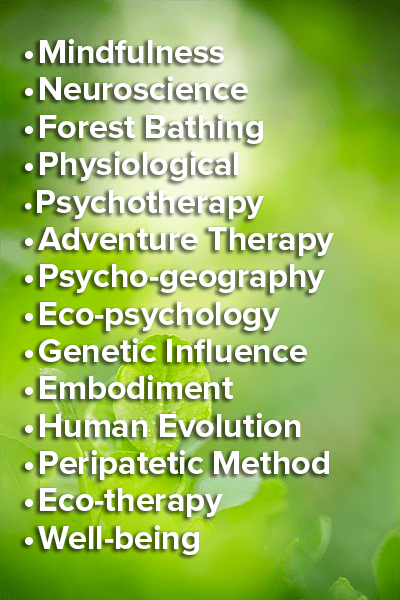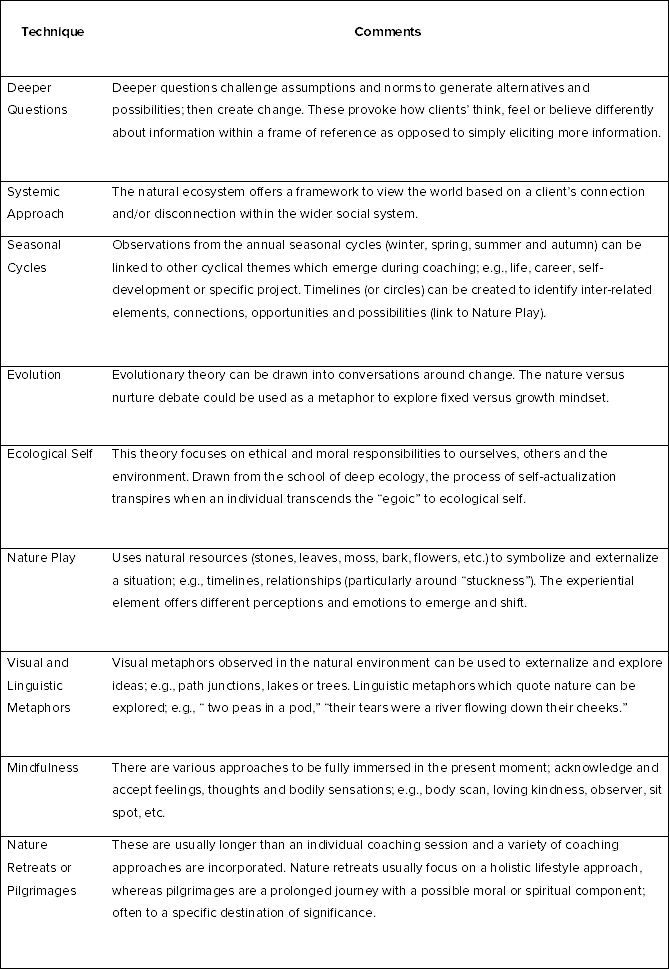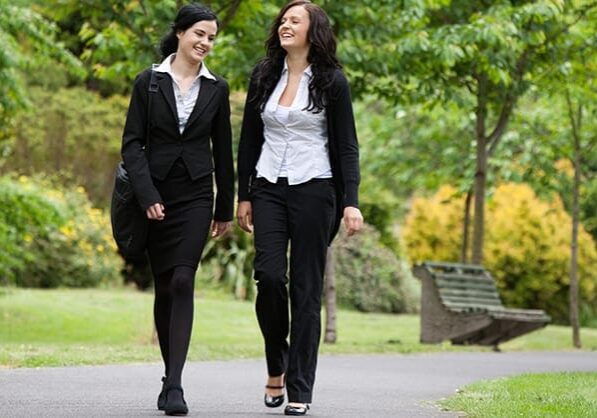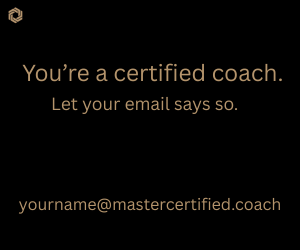“A journey of a thousand miles begins with a single step.” —Confucius
The advantages of heading outdoors and being immersed in nature, combined with physical movement, is increasingly attracting attention as scientific research from a range of disciplines, which promote the benefits (see table 1), is publicized through mainstream and social media platforms. The opportunity for coaches to integrate these fundamental elements of nature and movement into their coaching practice offers a range of physical, mental, emotional and spiritual positive attributes for their clients.

Table 1: Evidence-based research from these disciplines support the benefits of time in nature and physical movement.
Practical Considerations
The practical considerations behind how to plan and prepare for working with coaching clients outdoors can be covered working through the WALKTALK acronym:
Walking Works Wonders
An Open Mind
Location, Location, Location
Keep Plan B in Mind
Test It Out
Add Element Creativity
Look into Health Safety
Keep It Fun
Walking Works Wonders
Scientific research is continuing to prove centuries worth of human collective knowledge and experience. From experience, the majority of my coaching clients who are willing to step outdoors already intuitively understand the wonders of walking and talking coaching conversations.
“My clients have repeatedly described they feel more at ease while walking next to me, the coach, versus sitting opposite in a consultation room, which can feel intimidating. There is more of a sense of equality while walking next to each other. Also, they say allowing silence to be there is easier while walking versus sitting opposite the coach in a room,” says coach Karen Liebenguth of Green Space Life Coaching.
An Open Mind
There’s a duality to this element: firstly, embracing an open mind to explore a new coaching methodology, and secondly, experiencing feelings of openness, which seem to naturally emerge from being outdoors combined with movement.
“The feeling of openness, rather than intensity, leads to a more open, honest and focused session with fewer distractions,” says Naomi Korolanyi who is one of my clients and and HR Director at The National Composites Centre, a public/private sector engineering organization.
Location, Location, Location
The “where” can make or break an outdoors coaching session as the choice of location can positively enhance or disrupt the entire experience. Think about accessibility, route, terrain and other users.
Walking and talking coach Melanie Faulks, of Agdela Coaching and Fresh Air Fridays, explains, “Choose a location(s) where you feel comfortable, at ease and inspires you personally. Ideally venue(s) with different route and length options too but this isn’t always do-able. Buy an OS map. Look on local council and wildlife/nature/environment related charity websites for your local green areas—sometimes you discover outdoor options you didn’t know existed!”
Keep Plan B in Mind
Ultimately the decision to cancel, change location or reschedule is a judgment call. In your role as coach, part of your responsibility is managing the risk of taking coaching conversations outdoors to ensure both you, your client and other members of the general public are safe.
In the words Cat Treblico, of Reach the Peak Coaching and another fellow walking and talking coach, “The Scottish weather can [be a challenge] but I adapt my plans, and often use the weather as a metaphor for whatever is going on. In three years of coaching, I haven’t yet had to cancel a session.”
Test It Out
Before taking the plunge and subjecting your clients to a completely new coaching idea, it’s worth testing out the concept in advance with your peers. “Find a collaborator and try it,” says Mike White, of Mike White Coaching.
Add Element Creativity
Creativity naturally emerges from being outdoors and the coaching techniques discussed below are examples which can be integrated into walking and talking coaching (see table below).
“[My clients] say that they feel more creative about solutions to their issues, have breakthroughs more easily while being in nature and surrounded by wide open space,” according to Liebenguth.

Table 2: Different creative coaching techniques which can be included in walking and talking coaching sessions
Look into Health Safety
Heading outdoors invites an additional element of physical, mental and emotional risk into the process beyond the safety of four walls, for both yourself, as the coach, and your client. Ensure you’ve reviewed outdoor qualifications, first aid, insurance and legal implications which will vary from country to country.
Keep It Fluid
The key to walking and talking coaching is to organically interweave existing coaching methodologies, theories and styles. The extent to which the outdoor space and/or embodied practice is openly acknowledged can range from nature unconsciously forming the backdrop to actively inviting nature to co-create the coaching process. As Albert Einstein said, “Look deep into nature; and then you will understand everything better.”
______________________________________________________________________________________________________________________________________
Anna-Marie Watson, PCC, will be exploring this topic more in-depth at ICF Converge 2019, which is taking place October 23-26 in Prague, Czech Republic. Join her session “Step Outside: Taking Coaching Conversations Outdoors” in the Practice content group on Thursday, October 24 at 3:00 p.m. (local time). By attending this session, you can earn 0.5 RD in Continuing Coach Education units.
Disclaimer
The views and opinions expressed in guest posts featured on this blog are those of the author and do not necessarily reflect the opinions and views of the International Coach Federation (ICF). The publication of a guest post on the ICF Blog does not equate to an ICF endorsement or guarantee of the products or services provided by the author.
Additionally, for the purpose of full disclosure and as a disclaimer of liability, this content was possibly generated using the assistance of an AI program. Its contents, either in whole or in part, have been reviewed and revised by a human. Nevertheless, the reader/user is responsible for verifying the information presented and should not rely upon this article or post as providing any specific professional advice or counsel. Its contents are provided “as is,” and ICF makes no representations or warranties as to its accuracy or completeness and to the fullest extent permitted by applicable law specifically disclaims any and all liability for any damages or injuries resulting from use of or reliance thereupon.
Authors
Post Type
Blog
Audience Type
Coach Educators, Experienced Coaches, External Coaches, ICF Chapter Leaders, Internal Coaches, New Coaches, Professional Coaches, Team and Group Coaches
Topic
Coaching Toolbox, Discover - Your Coaching Career
Related Posts
How Coaching Is Driving Inclusion Around the Globe: Lessons from Local ICF Chapters
When a group of mothers in Kazakhstan, many of whom had never…
Belonging Beyond Numbers: How ICF Demographic Trends Are Shaping the Future of Coaching
What does it really mean to belong? For the International Coaching Federation…
Professional Coaching Relationships That Work: Respect, Boundaries, and the Art of Mutuality
This post comes from Dr. D. Ivan Young, an ICF Business Solutions…








